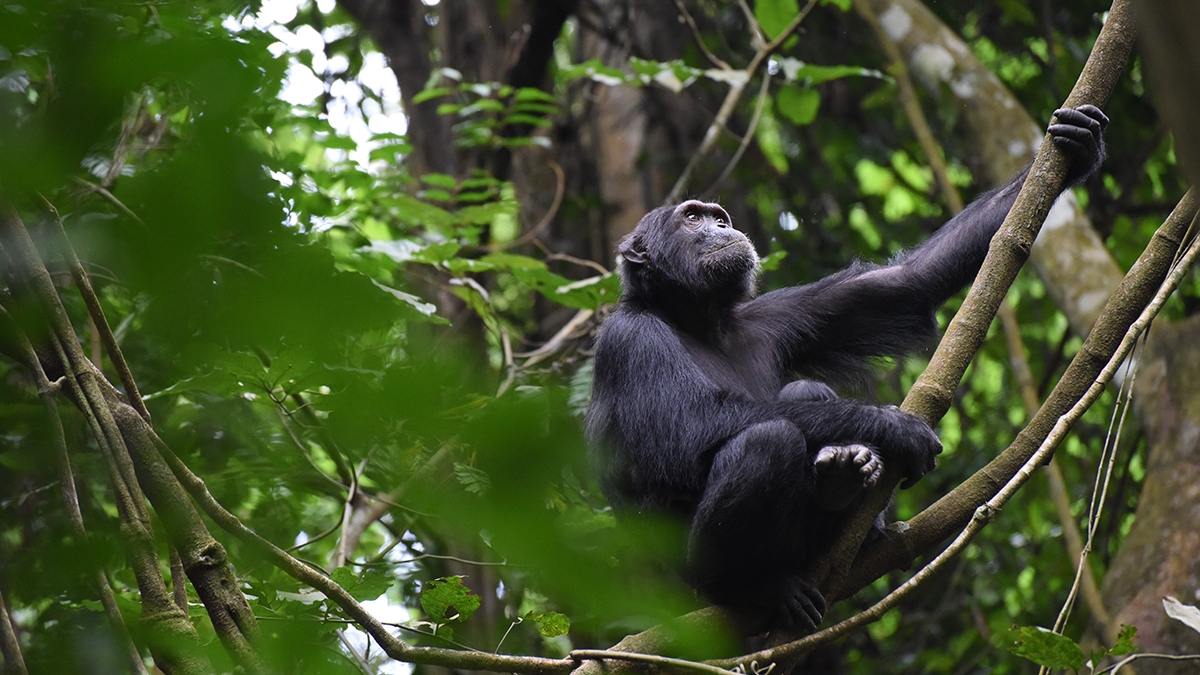Jane Goodall Institute chimpanzee archive coming to ASU

Gombe chimpanzee. Photo by Ian Gilby
The physical archive of over 60 years of observations of wild chimpanzees in Gombe National Park, initiated by Jane Goodall — founder of the Jane Goodall Institute and U.N. messenger of peace — and comprising hundreds of thousands of handwritten notes by hundreds of researchers, will find a new home at Arizona State University’s newest, state-of-the-art research building, Interdisciplinary Science and Technology Building 7 (ISTB7).
The archive — the Jane Goodall Institute Gombe Research Archive — will be overseen by primatologist Ian Gilby, Institute of Human Origins research scientist and associate professor with the School of Human Evolution and Social Change.
By the late 1960s, a remote outpost in Tanzania was bustling with field assistants and students studying wild chimpanzees in Gombe National Park. This research, begun by renowned ethologist and conservationist Jane Goodall, transformed our understanding of our closest living relatives and, in turn, our own place in the world. Her early observations of chimpanzee tool use, hunting and complex social relationships revolutionized the field of primatology. Since that time, a dedicated team has collected daily handwritten data on chimpanzee life — grouping, feeding and ranging — on check sheets, as well as longhand narrative observations of behavior, including grooming, tool use, dominance and mating.
In the early 1990s, a massive effort to organize, protect and analyze data from this priceless archive was spearheaded by Gombe researcher Anne Pusey. The data was organized into a powerful relational database that has resulted in many exciting and important discoveries that build upon Goodall’s early findings and continue to be essential to a long-term understanding of chimpanzees. Gilby is the director of the Gombe Chimpanzee Database, the digital repository of the physical archive.
Following the recent retirement of Pusey, the Jane Goodall Institute forged a new partnership with the Institute of Human Origins at ASU, where the archive and database will be curated by Gilby, a 20-year researcher at Gombe, who was a graduate student of Pusey’s. Because of its scientific and historical value, this priceless resource must be properly protected and preserved, while also remaining accessible to scientists.
“This is a dream come true,” Gilby said. “I have spent my whole career working with this amazing dataset, and I am humbled to be involved with its future, which promises many more exciting discoveries about our closest living relatives. I am particularly excited to make the data and our findings more accessible to a global audience.”
Lilian Pintea, Jane Goodall Institute vice president of conservation science, said, “We are excited to expand our collaboration with Ian Gilby and the new partnership with IHO at ASU to help us leverage Gombe long-term data as a global asset for interdisciplinary scientific research and conservation.”
Building on the Institute of Human Origin's expertise in primatology with chimpanzee researcher Kevin Langergraber at Kibale National Park in Uganda, and Regents Professor Joan Silk’s field research studying baboons in Kenya, the relocation of the collection establishes ASU and the institute as a global hub of noninvasive research on wild primates.
The priceless Gombe Research Archive deserves world-class storage. For the continued protection of these materials, an ASU Pitchfunder campaign has been started to upgrade the storage to fire- and water-proof filing cabinets fitted with acid-free, archival-quality folders. To become a supporter of the Jane Goodall Institute Gombe Research Archive fund, donate here.
More Science and technology

4 ASU researchers named senior members of the National Academy of Inventors
The National Academy of Inventors recently named four Arizona State University researchers as senior members to the prestigious…

Transforming Arizona’s highways for a smoother drive
Imagine you’re driving down a smooth stretch of road. Your tires have firm traction. There are no potholes you need to swerve to…

The Sun Devil who revolutionized kitty litter
If you have a cat, there’s a good chance you’re benefiting from the work of an Arizona State University alumna. In honor of…

